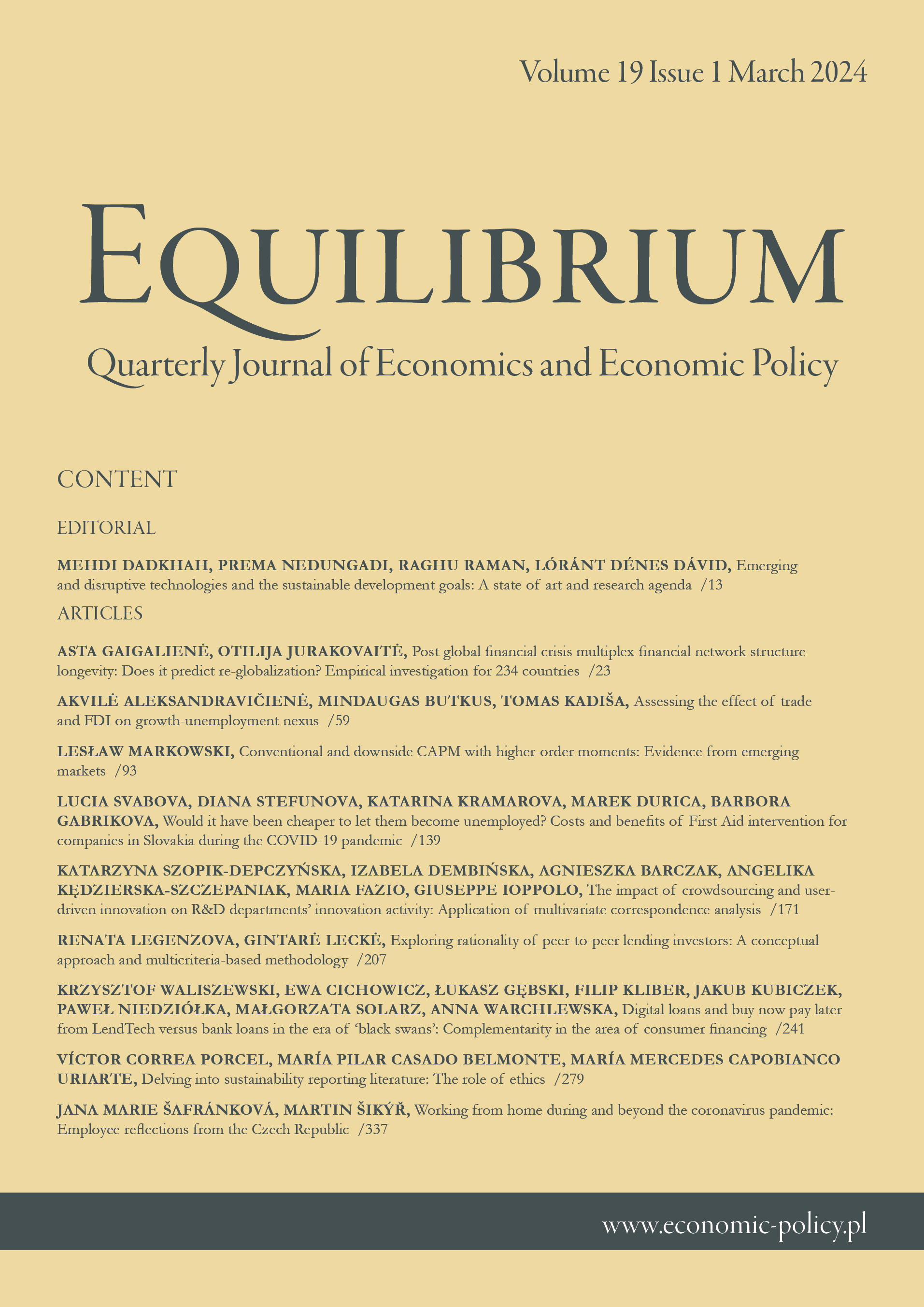欧洲各地区的技术融合
IF 6.2
Q1 ECONOMICS
Equilibrium-Quarterly Journal of Economics and Economic Policy
Pub Date : 2020-06-24
DOI:10.24136/eq.2020.014
引用次数: 23
摘要
研究背景:鉴于创新和技术进步在塑造区域经济发展中的关键作用,以及创新过程在区域层面的空间维度的重要意义,区域范围内的技术趋同评估成为一个重要的研究问题。可以在全要素生产率分析的基础上确定技术趋同。技术趋同分析的重要性来自于这样一个事实,即收入趋同既可能加速,也可能阻碍,这取决于技术水平的初始差异是随着时间的推移而减少还是增加。文章的目的:本文的目的是双重的。首先,我们试图建立一个分析技术趋同的理论框架。其次,我们调查了欧洲地区的技术趋同(基于TFP分析)。方法:在研究的第一阶段,我们使用乘完全Fare Primont指数来计算TFP。研究的第二阶段包括对用于评估欧洲各地区技术趋同水平的空间面板模型的估计。研究样本包括2010年期间的273个NUTS 2欧盟(EU)地区?2016年。研究结果和附加值:研究结果证实,欧洲明确划分为全要素生产率高的西欧地区和全要素生产率低的东欧地区。研究还表明,东欧地区缩小生产力水平差异的进程比西欧地区更快。由于技术趋同问题在相关文献中仍未得到充分探讨,本文试图填补欧洲区域空间技术趋同研究中的认知和方法空白。本文章由计算机程序翻译,如有差异,请以英文原文为准。
Technological convergence across European regions
Research background: Given the pivotal role of innovations and technological progress in shaping the economic development of regions and the crucial significance of spatial dimension of innovation processes at the regional level, the assessment of technological convergence in the regional scope becomes an essential research problem. Technological convergence could be identified on the basis of the analysis of total factor productivity (TFP). The significance of the technological convergence analysis results from the fact that income convergence can be both accelerated or impeded, depending on whether the initial differences in the level of technology (TFP) decrease or increase over time.
Purpose of the article: The aim of the paper is twofold. Firstly, we attempt to develop a theoretical framework for the analysis of the technological convergence. Secondly, we investigate the technological convergence (on the basis of the TFP analysis) across European regions.
Methods: During the first stage of the research, we employ the multiplicatively-complete Fare-Primont index to calculate TFP. The second stage of the study includes estimation of spatial panel models applied to assess the level of technological convergence across European regions. The research sample consists of 273 NUTS 2 European Union (EU) regions over the period 2010? 2016.
Findings & Value added: The results of the study confirm a clear division of Europe into the Western European regions with high TFP values and the Eastern European regions with low TFP level. The research also shows that in the Eastern European regions the process of reducing the differences in the productivity levels is faster than in Western European regions. Since the issue of technological convergence is still not sufficiently explored in the relevant literature our paper attempts to fill a cognitive and methodological gap in the investigation of the technological convergence in the European regional space.
求助全文
通过发布文献求助,成功后即可免费获取论文全文。
去求助
来源期刊
CiteScore
9.20
自引率
3.50%
发文量
28
审稿时长
36 weeks
期刊介绍:
Equilibrium. Quarterly Journal of Economics and Economic Policy is a scientific journal dedicated to economics, which is the result of close cooperation between the Instytut Badań Gospodarczych/Institute of Economic Research (Poland) and Polish Economic Society and leading European universities. The journal constitutes a platform for exchange of views of the scientific community, as well as reflects the current status and trends of world science and economy.
The journal especially welcome empirical articles making use of quantitative methods in: Macroeconomics and Monetary Economics, International Economics, Financial Economics and Banking, Public Economics, Business Economics, Labor and Demographic Economics, Economic Development, and Technological Change, and Growth.
Current most preferable topics and special issues:
The economics of artificial intelligence: business potentials and risks;
Digitalization and entrepreneurship in economics;
Sustainable socio-economic development, environmental and ecological economics;
Transition in the energy market (improving energy efficiency, alternative energy sources, renewable energy, energy security).

 求助内容:
求助内容: 应助结果提醒方式:
应助结果提醒方式:


